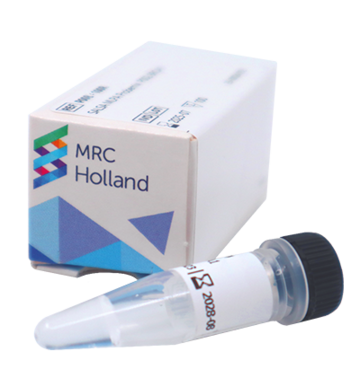The beta-globin gene cluster, consisting of five functional genes (HBE1, HBG2, HBG1, HBD and HBB), is located on the short arm of chromosome 11. Five nuclease hypersensitive sites are located upstream of this locus, constituting the beta-globin locus control region (LCR) which is responsible for correct transcription of the globin genes. Mutations involving one or more of the genes and/or the LCR may lead to a variety of haemoglobin disorders, together referred to as haemoglobinopathy.
Beta-thalassaemia is an autosomal recessive disorder, characterised by a reduction or absence of beta-globin chain production. Depending on the type of mutation, beta-thalassaemia patients experience a wide variety of symptoms, ranging from mild anaemia to severe transfusion-dependent haemolytic anaemia.
Beta-thalassaemia can be classified into three categories:
Beta-thalassaemia minor: carrier of a single beta-thalassaemia mutation. Carriers present with microcytic hypochromic anaemia, however, in general they do not require any treatment.
Beta-thalassaemia intermedia: both beta-globin genes are affected by (usually not completely inactivating) mutations. A substantial amount of functional beta-globin chains is still produced. Patients require sporadic blood transfusions, iron chelation therapy and folic acid supplementation. In some cases, a splenectomy may be necessary.
Beta-thalassaemia major (also known as Cooley’s anaemia): function of both beta-globin genes is completely disrupted, leading to severe haemolytic anaemia, jaundice, hepatosplenomegaly and dysmorphic features due to expansion of the bone marrow. Patients are dependent on life-long regular blood transfusions and iron chelation therapy to survive. The only option for cure at this moment is bone marrow transplantation from a matching donor.
Until now, more than 600 point mutations in the HBB gene have been described (http://globin.cse.psu.edu/hbvar/menu.html) that lead to structural variants of the beta-globin chain and subsequently to abnormal haemoglobin molecules. A relatively small number of these abnormal haemoglobins can cause severe disease in homozygous or compound heterozygous combinations. The most frequently occurring mutation is the Haemoglobin S (HbS; HBB:c.20A>T, p.Glu7Val) mutation. Other well-known haemoglobin variants are HbC, HbE, HbD-Punjab and HbO-Arab. Homozygosity for HbS or combined heterozygosity of HbS with a beta-thalassaemia mutation, a deletion of the HBB gene or with another haemoglobin variant causes sickle cell disease (SCD). SCD patients suffer from infarctions in the microcirculation which lead to severe pain crises and organ damage, particularly in the bones, spleen, heart and lungs. Treatment consists of pain management and regular blood transfusion or erythrocyte exchange transfusion. Like for beta-thalassaemia major, the only option for cure at this moment is bone marrow transplantation.
In addition to beta-thalassaemia, deletions in the beta-globin gene cluster may also lead to other types of haemoglobinopathy. Depending on the gene(s) involved, they include epsilon-gamma-delta-beta-thalassaemia, gamma-delta-beta-thalassaemia, delta-beta-thalassaemia and hereditary persistence of foetal haemoglobin (HPFH). These conditions cause a variety of phenotypes, ranging from borderline-normal haematological indices with high levels of HbF (up to 40%) to microcytic hypochromic anaemia comparable to ‘regular’ beta-thalassaemia. During embryonic and foetal development, carriership of epsilon-gamma-delta-beta-thalassaemia can lead to severe haemolytic anaemia which may require intra-uterine blood transfusion (https://www.ncbi.nlm.nih.gov/books/NBK1426/; Weatherall 2010; Steinberg et al. 2009; Galanello et al. 2010).





